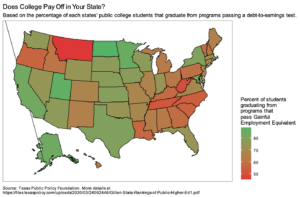Students enroll in college for a variety of reasons, and getting a better job is rated as a very important reason by 85% of them. One marker of a “good” job is earning enough to be able to repay student loans. But until recently, students were forced to guess which colleges and majors would fit that bill.
While some information on earnings and debt was available, it was generally based on small and unrepresentative surveys or highly aggregated at the type of degree or the university level.
But that changed last fall when the Department of Education began releasing the typical earnings and debt by college program. This new data means that for the first time ever, a student interested in majoring in accounting can compare the typical earnings and debt of recent graduates from accounting programs across the country. Or a student wanting to change majors can look up which programs at their college have the lowest debt or the highest earnings. All this new data is available at the federal government’s College Scorecard website, and the Texas Public Policy Foundation has created a webtool that is more user friendly and customizable.
This new data is likely to unleash two tsunamis on higher education: more informed consumers and new accountability measures imposed by government based on labor market outcomes.
But what should those new accountability measures look like? The most promising path, ironically enough, would follow the contours of the Obama administration’s Gainful Employment regulations. These regulations were inappropriately targeted at for-profit colleges, but did contain the good idea of cutting off a college’s access to financial aid programs when students had too much debt relative to their post-college earnings. Making slight adjustments to account for differences in the definition of programs, and the measurement of earnings and debt, we’ve created what we call Gainful Employment Equivalent, and applied it to all of higher education rather than just the for-profit sector.
In a new report, “An Economic Ranking of State Public Higher Education Systems: 2019-2020,” we applied Gainful Employment Equivalent to see which states’ public college systems are doing the best job at passing this debt-to-earnings test. A state’s performance is determined by the percent of its students graduating from a program that passes the debt-to-earnings test. The map below shows how each state performed.

These results show a wide range of performance across the nation. North Dakota does the best, with 89% of its public college students graduating from programs that pass the debt-to-earnings test. Montana does the worst, with only 45% of students graduating from programs that pass the debt-to-earnings test.
While the data is far from perfect — e.g., the earnings data is only for the first year after graduation and only includes those who received federal financial aid — it is the most complete data we have. It also precisely covers the population that would be affected by changes to financial aid programs.
While it is prudent to wait for another year or two’s data to confirm the findings, these results can begin to inform policymaking at both the state and federal level. At the state level, poorly performing states should ask why so many of the programs offered by their public colleges failed the debt-to-earnings test. Either the colleges and their governing boards didn’t know that many of their programs hurt their students’ financial futures, or they knew and chose to do nothing. Either one is a damning indictment of their public higher education systems, a justification for a radical overhaul in many states.
At the federal level, higher education’s accountability “triad” — the federal Department of Education, state authorization, and accreditation — was clearly not up to the task of identifying and policing programs with dismal results. We argue that this warrants a new approach to accountability that takes seriously the goals of most students by considering the labor market outcomes of recent college graduates. The gainful employment equivalent test utilized here is one promising method of accomplishing this goal.
